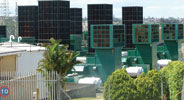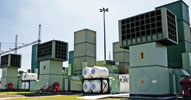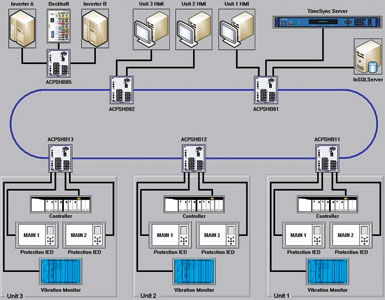
If ever there was a time to be ready for peak power demands, it was during the 2010 FIFA World Cup held in the heart of a South African winter. Thankfully, Eskom’s Acacia and Port Rex gas turbine power stations were ready for action well ahead of schedule thanks to a rigorous upgrade programme.
Eskom’s Cape Town-based Peaking Generation unit is responsible for meeting peak power demands on the national grid at a moment’s notice. This geographically distributed initiative, consisting of hydro-electric, pump storage and gas turbine plants, is maintained in a high state of readiness at all times with the help of monitoring systems that are continuously updated to maximise the benefit of evolving technologies.
Background
Acacia power station is situated on the outskirts of Cape Town in the Western Cape and Port Rex power station at East London in the Eastern Cape. Each station has three 57 MW gas turbine generator units where each unit is a ‘twin-pack’ FT4 Pratt and Whitney gas generator set incorporating turbines that are similar to the engines of a Boeing. The result is that each of these stations can generate a total of 171 MW that can be channelled to the national grid at a moment’s notice.

The Port Rex power station is at the end of a very long transmission line and its main purpose is to stabilise the voltage on that line by running in synchronous condenser mode for most of the time and only switching over to its generating mode on demand.
Acacia also provides line stabilisation but its most important role is as backup electrical supply to the Koeberg nuclear plant. If Acacia does not have sufficient generating capacity and redundancy available, Koeberg has to be shut down – so it carries a huge responsibility. Both Acacia and Port Rex can be operated by remote control from Eskom’s National Control Centre in Germiston to provide back up and ‘black start’ capability (the ability to start operating without the need for external power).

Since their commissioning in 1976, the control systems for Acacia and Port Rex had remained largely untouched and consisted of hardwired relay logic and analogue power governors which had since become obsolete. Protection was implemented through electro-mechanical relays, but this was simply no longer good enough as senior advisor for Eskom Peaking Generation, Abdul Gaffaar Hoosain explains.
“For example, when a plant is brought on-line, which often needs to happen in just a couple of minutes, it is vital to avoid trips or other failures as this would defeat the rapid response requirement. However, if the system does fail, it is vital that the root cause of that failure be determined as soon as possible and, more importantly, make sure that the conditions which caused it are not only understood but are eliminated in the future. To this end, scada systems can contribute enormously to our knowledge and analysis of the cause of incidents.”
The obsolescence of the control systems coupled with the very limited availability of expert knowledge to keep them running, as well as the absence of historical plant information and the impossibility of remote engineering support, prompted Eskom to review its options. In 2007, the company decided that an upgrade of these critical resources was in order.
How it was done
“We contacted the OEM that installed the original system and they indicated that they were able to implement what we wanted and offered solutions based on a number of alternative options,” says Hoosain. “Our primary decision was that we wanted the new system to be based on Wonderware’s Historian and InTouch HMI/Scada. Our good relationship and experiences with Wonderware and the excellent level of support and training we have received in the past, meant that the choice of other elements in the implementation would be influenced by the degree of compatibility with the Wonderware platform.”
The OEM was appointed as the responsible party for building and factory testing the entire control system, which was initially implemented at its facility in Colorado. The OEM was also to supply Eskom with a commissioning engineer for the installation phase of the project.
Figure 1 shows an overview of the system at any one of the power stations where the switches, controllers, PLCs, protection relays, vibration monitors, HMIs and the Historian all get their timing information from the TimeSync Server (top right). The fault toleration ring network (shown in blue) will continue to operate should any of its segments fail, thereby maintaining communications between the HMI and other segments of the network.

Eskom’s responsibilities included the design and installation of the Ethernet network and time synchronisation system, as well as the design of the protection system and implementing the historian. Eskom also provided InTouch support during commissioning and was responsible for the installation of the entire deliverable system.
“The adoption of the IEC-61850 OPC interface software standard (Figure 2) allowed us to have far more control over the information we wanted and all parties involved in this project collaborated to help us achieve our information goals,” explains Hoosain.

The supplied HMI application was based on InTouch 7.0 and this was immediately upgraded to InTouch 10 which involved creating new graphics and implementing standards. “Perhaps the most important development was making the application unit independent,” says Hoosain. “This meant removing all the hard coded unit specific details and creating a standardised environment that would accommodate all the individual units at both Acacia and Port Rex.”
The implementation of the new system came complete with its own set of challenges ranging from getting operator buy-in to the fact that, in Acacia’s case, only one unit was allowed to be unavailable at any time in order not to jeopardise Koeberg’s status.
Benefits
* Successful upgrading of mission-critical power stations through the installation of modern scada facilities without interruption to service or the black start capabilities of either site.
* Enthusiastic response from operations, maintenance and engineering staff.
* Enhanced in-house skill set.
* Ability to implement any enhancements requested after the upgrade.
Conclusion
Information is obviously the key to improved control, when that control can influence the way of life of millions then it must be applied with great care. Eskom’s Acacia and Port Rex power stations, when compared to their coal and nuclear colleagues, are diminutive but equally vital to contributing to a better way of life in South Africa.
For more information contact Jaco Markwat, Wonderware Southern Africa, 0861 WONDER, [email protected], www.wonderware.co.za

© Technews Publishing (Pty) Ltd | All Rights Reserved